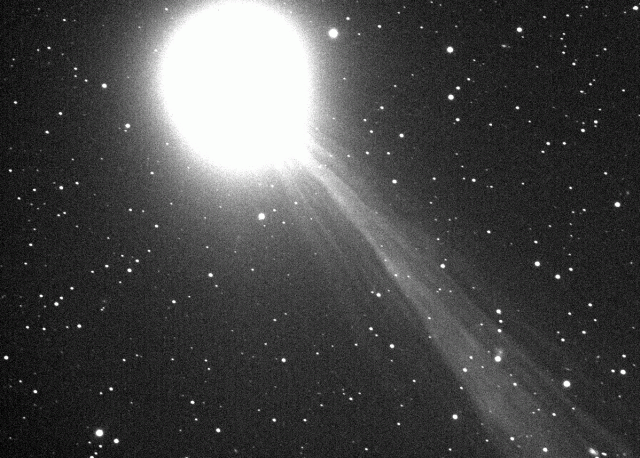Object name: C2006M4 SWANDesignation(s): C2006M4_SWAN, In late October of 2006, my observatory was just getting up and running when Comet Swan M4 came by the earth in the early evening sky. I had little experience with imaging a comet and none in trying to get a "movie" of it. I had beginner's luck. Not having but a glimmer of how to do it I succeeded beyond my expectations. The comet turned out to be very active on the evening of October 29th UT. It was still a rather bright sky but it was setting in the west so I gave it a try before it set behind my roof. I took 30 one minute shots which I then stitched together into a 4+ megabyte animated GIF. I was hoping to get its motion through the stars. I got far more.
I did succeed in showing that the tail of a comet doesn't necessarily point behind its direction of travel as many believe including some textbooks used in public schools. Instead, it is pushed back by the solar wind so, at least at first, points away from the sun. This is especially true of the ion tail which is made up of ionized gasses so also responds to the sun's magnetic field. Comet Swan had a very active ion tail. So active my animation caught the gasses flowing away from the head of the comet and down the tail. Even in 30 minutes, the motion was obvious. This came as a total surprise. Since then I've made movies of several other comets but none showed any motion in the tail.
Also, the tail responds to the sun's magnetic field. If a comet's orbital motion carries it across a strong field line and into another the ion tail can disconnect and flow away as a new one develops. This happened to Comet Swan a few hours after my animation stops. It stopped because it was right over my chimney and my wife not knowing I was pointed right there lit newspapers to start up the fireplace as we heat with wood in winter evenings after turning off the gas furnace. The sparks from the newspaper made further frames useless. Not that it mattered as the comet went behind the chimney a few minutes later.
Note however there are many short streamers coming from the head of the coma. In the first frames these are along a rather wide arc of the coma but by the end, they are narrowing down quite a bit. This likely was a precursor to the tail disconnect a couple hours later. If I was a few time zones west I might have caught the disconnect in the movie. No one did and as far as I know, no one caught any of the motion in the tail this one did.
I had been asked if I could make a movie of it to show the tail didn't flow behind the comet. I'd likely never have taken this without the request as I had no idea how to do it. The professional astronomer who asked me if I could do the movie was thrilled with the animation and said I should submit it to NASA's Astronomical picture Of the Day website. Not going through the right channels I was ineligible for an APOD but they did accept it for a link. You can see the short version I submitted at https://apod.nasa.gov/apod/ap061106.html then click on the text link "move outward" to see my animation. This short version skipping frames makes it easier to see the pinching of the streamers prior to the tail disconnect. The movie is used by many science teachers so is likely my most successful image and it was taken only by beginner's luck and in mostly ignorance rather than knowledge.
Note one frame is missing so it jumps slightly in the full version. My wife's first attempt to start the fire failed but not before sending up some nasty sparks. I didn't see the frame as it came in so didn't stop her from trying again a few minutes later. I had to pull that frame. Since my camera needs a few seconds to download each image and start another the movie covers about 33 minutes of time, not 30. Note two a few galaxies pass through the tail as the sky moves to the left due to the comet's orbital motion. It was too far west the next day so I couldn't try again.
14" LX200R @ f/10, 29x1' binned 3x3 (30 taken, one unusable), STL-11000XM, Paramount ME | | 